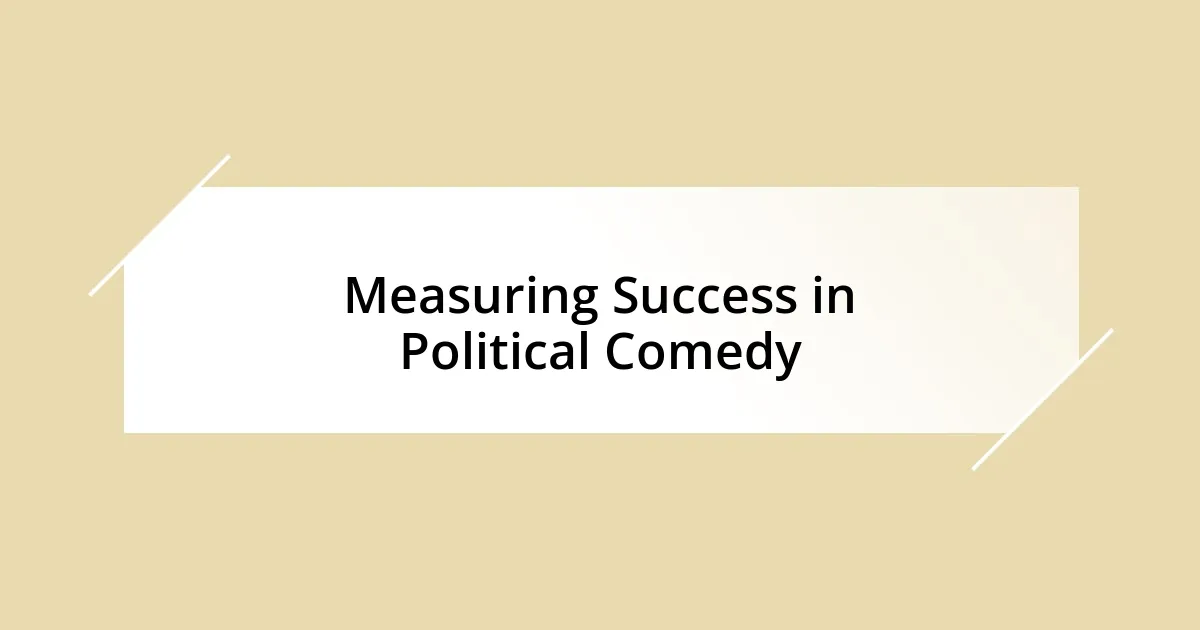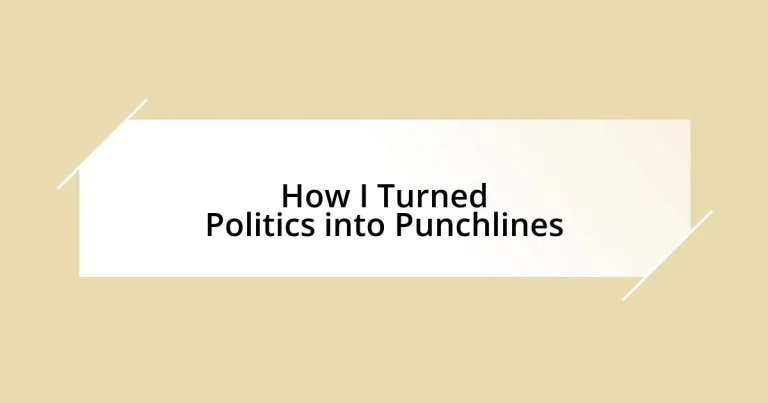Key takeaways:
- Political humor can simplify complex issues, fostering connections and encouraging dialogue.
- Crafting relatable jokes involves tapping into shared frustrations and current events, emphasizing audience connection.
- Balancing humor and sensitivity is crucial; understanding audience backgrounds ensures jokes enhance rather than alienate.
- Engagement through social media amplifies humor’s reach, transforming a single joke into widespread discussion.

Understanding Political Humor
Political humor is a fascinating blend of wit and timing. I remember the first time I crafted a political joke that resonated deeply with an audience; the laughter that followed felt like a collective release. It struck me then how humor can break down the barriers that often surround political discussions.
Have you ever found yourself chuckling at a late-night host’s take on a political scandal? There’s something invigorating about how humor can distill complex issues into relatable commentary. I often reflect on my own experiences, where laughter helped forge connections during contentious debates, turning tension into shared amusement.
Through the lens of a punchline, serious matters become accessible. I’ve discovered that when I turn awkward political conversations into jokes, it not only lightens the mood but also inspires dialogue. Isn’t it remarkable how a well-timed quip can encourage people to reconsider their perspectives while they’re still laughing?

Identifying Key Political Events
In my experience, identifying key political events can feel like piecing together a jigsaw puzzle. When I pay attention to the headlines or hear about a heated debate, those moments stand out, often rich with material for humor. The thrill of finding a goldmine of comedic potential in a major political upheaval is something I cherish.
Take the impeachment trials, for instance. I remember watching one unfold—it was both surreal and entertaining. The gravity of the situation contrasted with the absurdity of some statements made. Those moments became instant punchlines for me, where the serious nature of politics and the absurdity of human behavior collided.
What I’ve learned is that staying alert to evolving narratives can help pinpoint when to strike with humor. Certain events have the power to resonate on many levels, and I always jot down thoughts immediately after witnessing these moments. This practice has proven invaluable for honing my craft.
| Event | Potential Punchline |
|---|---|
| Debates | “It’s like watching a reality show—who knew politics could be so entertaining?” |
| Legislation Announcements | “They say change is good, but have you checked their poll numbers?” |

Crafting Relatable Jokes
One of the keys to crafting relatable jokes is tapping into shared emotions and experiences. I often ask myself, “What common frustrations do people face in politics?” This inquiry leads me to explore topics like bureaucracy, political ads, or even the weather when it affects voting day. Reflecting on my own experiences, I remember the collective eye rolls during an endless political campaign season; that shared annoyance became a rich source of humor.
- Start with universal themes: bureaucracy, taxes, and election seasons.
- Find the absurdities in everyday political life, like the confusion over voter ID laws.
- Use exaggeration for comedic effect; a little theatrics can drive the point home.
- Relate jokes to current events, ensuring they resonate with ongoing discussions.
- Emphasize the relatable frustration, converting common annoyances into punchlines.
Crafting relatable jokes isn’t just about the punchline—it’s about the audience’s connection to it. For me, observing my friends’ reactions to political news often inspires how I frame my humor. There’s something so satisfying about compiling reactions into a joke that everyone finds amusing, reminding us that while politics can drive us to despair, laughter can be a bridge toward understanding.

Balancing Humor and Sensitivity
Finding the right balance between humor and sensitivity in political comedy can feel like walking a tightrope. I remember sharing a joke about a controversial bill at a gathering, only to notice a friend’s discomfort. It hit me then—what makes one person laugh can make another cringe. This realization taught me that understanding my audience’s backgrounds and experiences is paramount.
I often reflect on the fact that humor can be a powerful tool for discussing difficult topics, but it also requires an awareness of boundaries. There have been times when I’ve opted to tone down a punchline because it crossed a line I wasn’t prepared to face. For instance, I once joked about a political figure who had recently lost a family member. While I believed it would spark laughter, I paused and felt the room’s heaviness. My own discomfort reminded me that timely sensitivity can enhance the effectiveness of humor, making it engaging rather than alienating.
Navigating this delicate balance pushes me to ask: how do we create humor that fosters connection without causing offense? Often, I employ a technique of layering humor with empathy. When crafting jokes, I make sure to include elements that invite my audience into a shared experience, allowing laughter to emerge from a place of understanding rather than ridicule. This approach not only enriches the content but also strengthens the bond between me and my audience.

Utilizing Social Media for Impact
Utilizing social media effectively can amplify the reach of my political humor. The sheer amount of time people spend scrolling through platforms like Twitter or Instagram gives me ample opportunities to test out punchlines. I remember the rush I felt when a simple tweet about a political blunder went viral overnight; suddenly, my humor influenced conversations beyond my immediate circle.
Crafting catchy hashtags has become a game-changer as well. I once tagged a post with #TaxSeasonFrustrations, and it sparked a flurry of relatable responses. Engaging with followers in the comments helps me gauge what resonates and what doesn’t, allowing me to refine my material. Does anyone else find delight in unexpected connections from a joke shared online?
Incorporating multimedia elements—like memes and short videos—also enhances my impact. There’s something exhilarating about blending humor with visuals. For example, I created a short skit poking fun at political debates, and the comments section was flooded with viewers sharing their own debate horror stories. That kind of interaction fuels my creativity and deepens my understanding of what my audience values most.

Engaging Your Audience Effectively
Connecting with an audience is essential when I’m delivering political humor. I vividly recall a time at an open mic night when I decided to share a personal story about my voting experience. As I watched the crowd’s expressions change from curiosity to laughter, I realized that weaving my own narrative into political commentary forged a connection that mere statistics never could. It made me wonder: how can our individual stories collectively highlight larger societal issues?
I also find that using relatable, everyday language helps bridge the gap between humor and understanding. There’s nothing quite like hearing laughter when I describe my attempt to explain a complex policy to my grandmother—her bewilderment mirrored that of many people grappling with political jargon. It’s these shared moments of confusion and joy that make the message stick; it reminds me that, at the heart of comedy, we’re all just trying to navigate this messy political landscape together.
Another effective approach is to create interactive moments with the audience. I often ask questions mid-set, like, “Who else has argued with family over dinner about this issue?” This engagement not only encourages participation but also elicits laughter as people nod and chuckle at their shared experiences. It’s amazing to see how a little bit of involvement can transform a performance from a one-way presentation into a lively conversation. After all, laughter is best when it’s inclusive, reminding us that we’re all in this together.

Measuring Success in Political Comedy
Measuring success in political comedy can be a bit tricky, but I’ve found that audience reactions are the best indicators. One night, after delivering a set filled with punchy political jabs, I was blown away by a standing ovation. The energy in the room felt electric, and that was moment I knew I had struck a chord. But, it’s not just about the applause; it’s the laughter and conversations that linger long after I leave the stage that truly matter.
Engagement metrics, like shares and comments on social media, also play a crucial role in gauging success. I remember posting a satirical cartoon about a local debate, and it exploded with shares. Each interaction sparked a conversation among friends and family that extended far beyond my original post. It’s enlightening to see how a single joke can create waves of discussion, making me think: how can one punchline lead to a deeper understanding of a political issue?
Another way I measure success is through the unexpected moments—those times when a joke connects with a wider audience in ways I never anticipated. For instance, I once incorporated an inside joke about a local politician that only my friends would get. To my surprise, that joke resonated with a broader demographic, thanks to someone sharing it on a popular meme page. It makes me ask, how do we know what will resonate with the public until we take the leap and share our humor? That’s part of the thrill in political comedy; it’s as much an experiment as it is an art form.














